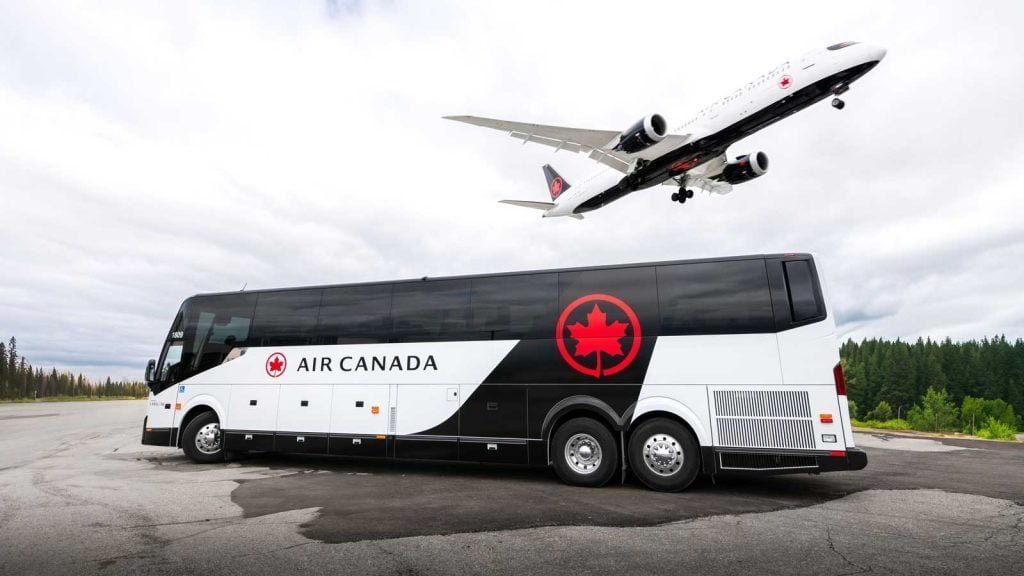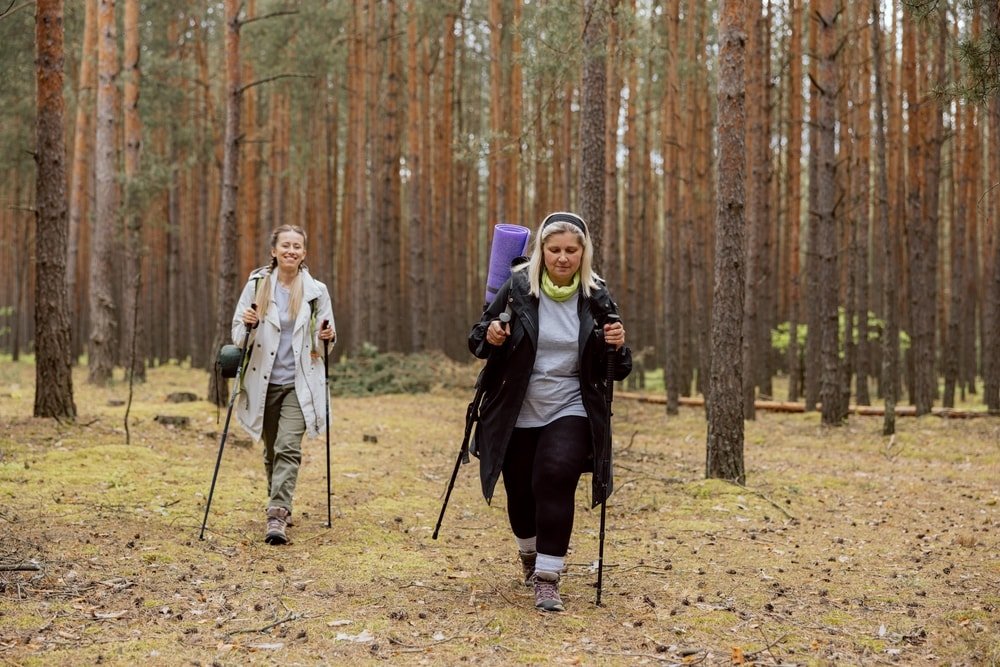Travel Trends
Air Canada expands landline luxury motorcoach service, connects Kingston to its global network

MONTREAL – Air Canada announced the expansion of its multi-modal Landline service that will enable customers at Kingston Norman Rogers Airport to seamlessly connect with its global hub at Toronto Pearson International Airport. The new luxury motorcoach service, with features such as spacious leather seats and fast, free Wi-Fi, will begin operating September 23rd with two return trips daily that are conveniently timed for connections to and from flights across Air Canada’s worldwide network.
“We are delighted to be reconnecting customers in Kingston and the surrounding region to our global network. This is a premier example of the new opportunities our growing partnership with The Landline Company unlocks. Customers travelling between Norman Rogers Airport and Toronto Pearson on Landline’s premium motorcoaches will enjoy the same benefits as those making air-only connections, including the convenience of a single itinerary and through-tagged baggage when departing Kingston, disruption protection, and Aeroplan earning opportunities,” said Ranbir Singh, Director, Regional Airlines and Markets, at Air Canada.
“We’re thrilled to expand our partnership with Air Canada into Eastern Ontario,” said Nick Johnson, Vice President, Commercial at Landline. “This new Air Canada service allows Kingston travellers to seamlessly book one-stop journeys on aircanada.com from Kingston Airport (YGK) through Toronto Pearson to Vancouver, Calgary, Edmonton, Halifax, and hundreds of Air Canada destinations worldwide, just as they would with a traditional connecting regional flight.”
“The return of Air Canada to Kingston marks a critical step forward in reconnecting our community to the global economy,” said Craig Desjardins, Director of Strategy, Innovation and Partnerships, at the City of Kingston. “Reliable, integrated transportation links like this are essential to supporting our tourism sector, enabling workforce mobility, and strengthening Kingston’s appeal as a destination for conferences, investment, and innovation. This partnership with Air Canada and Landline ensures that Kingston remains open, accessible, and competitive in a rapidly evolving economy.”
How it works
Air Canada and The Landline Company have operated intermodal services since May 2024 between Toronto Pearson and John C. Munro Hamilton International Airport in Hamilton and Region of Waterloo International Airport. With today’s expansion, Landline will now also operate two, non-stop round trips daily to Toronto Pearson from Kingston Norman Rogers Airport in eastern Ontario. Air Canada customers beginning their journey at Kingston will check in as normal for their flight, have their bags tagged and obtain boarding passes for all segments of their trip. At a designated departure point at the Kingston airport, they will board a luxury, Air Canada-branded motorcoach and their checked baggage will be loaded. Upon arrival at Toronto Pearson, customers will proceed directly to self-service bag drop, and then through security. For launch, many motor coach segments can be booked at no added fee, compared to journeys originating at Toronto Pearson. Air Canada is also issuing a fee waiver for customers looking to add motorcoach segments to existing bookings. Customers can reach out to the Air Canada Contact Centre to take advantage of the waiver until December 31st, 2025.
The new landline Kingston-Toronto service will commence operation on September 23rd, 2025.
| Number | Depart | Arrive | Frequency |
| AC2514 | Kingston (YGK) 04:00 | Toronto (YYZ) 06:50 | Daily |
| AC2515 | Toronto (YYZ) 08:10 | Kingston (YGK) 11:05 | Daily |
| AC2516 | Kingston (YGK) 14:00 | Toronto (YYZ) 17:30 | Daily |
| AC2517 | Toronto (YYZ) 19:10 | Kingston (YGK) 22:05 | Daily |
In the event of coach or flight delays, customers travelling on Landline will be automatically offered the same protections as customers travelling on air-only itineraries. Members of Air Canada’s Aeroplan program will earn points for both ground and air segments, as on any normal connecting flight itinerary. For more information see www.aircanada.com/landline
Premium motorcoaches
The motorcoaches used by Landline for Air Canada are made in Canada by Prevost, a manufacturer of touring coaches based in Sainte-Claire, Quebec. Each Landline motorcoach provides a premium experience, with 36 spacious, leather seats in a two-by-one configuration. The coaches are equipped with free Wi-Fi, power and a table tray available at each seat, generous overhead storage for carry-on baggage, and an onboard lavatory. Announcements will be made in both Official Languages and the coaches are fully accessible, including a power lift for customers requiring mobility aids.
Air Canada regional services
Air Canada operates to 40 communities across Canada, including in partnership with regional carriers Jazz Aviation LP and PAL Airlines. Through its innovative partnership with Landline, Air Canada is extending its regional network to conveniently connect local airports directly to its global network. There is potential to further expand the partnership with Landline to connect with other regional airports in Canada at a future date.
The article Air Canada expands landline luxury motorcoach service, connects Kingston to its global network first appeared in TravelDailyNews International.
Travel Trends
U.S. Traveler Trends in 2025: The Rise of Social Media, AI, and Online Travel Agencies Shape the Future of Travel

Monday, August 4, 2025
In 2025, U.S. travelers are expected to spearhead the global tourism market. Americans have historically taken business-centric trips, but now prioritize experience-oriented travel. The pervasive social media presence, AI, and OTAs have redefined how trips are planned, booked, and experienced. The new digital age shapes new expectations from tourism business, rethinking the ways they can assist travelers.
Travel Trends and Transitions in The United States for 2025
American travelers actively use the information provided by the U.S. travel agencies, especially social media, emerging technologies, and other online travel platforms. As technology improves, Americans are provided with new and enjoyable ways to travel. By 2025, the U.S travelers’ social media presence is expected to enable them to gain new travel experience online. The use of innovative technologies by the AI will aid significantly in the travel planning, seamlessly guiding each customer throughout the process.
In 2025, Online Travel Agencies (OTAs) have experienced a notable resurgence as a result of greater reliance on the digital channel for booking services such as lodging, transportation, and activities. Ease and a one-stop-shop platform have now become necessities for a modern traveler. As OTAs become more and more popular, the traditional methods of booking through a travel agent or directly with the airline have increasingly become obsolete, particularly for younger travelers.
AI is now being incorporated into travel applications and platforms, thus changing the planning and booking processes of trips. Real-time adjustments for flights and tailored destination suggestions are provided instantly for travelers. The booking experience is enhanced with the use of AI tools, where the anticipated travel preferences of users are processed and relevant options are provided almost instantaneously.
The rise of social media and digital storytelling is yet another important consideration. Travelers are increasingly turning to social media for research and inspiration. Travelers can discover destinations and experiences through Instagram and TikTok. As a result, there is an increase in collaboration between tourism brands, destinations, and influencers to promote authentic experiences and instill a desire to travel in prospective tourists.
The Experience-Driven Traveler: The New Era of Traveling
One of the most noticeable changes in the U.S. travel trends of 2025 is the transition from convenience, transactional travel to the experience-centered travel. Unlike the American travelers of the past who were satisfied simply visiting tourist destinations, modern American travelers wish to fully experience the region, its culture, and its people.
Travelers from the U.S. and abroad are increasingly looking for unique cultural experiences and deeper connections with the people and countries they visit. From participating in unique culinary classes at local markets and mastering age-old crafts with the locals to exploring hidden natural gems, American travelers are increasingly seeking authentic experiences instead of the usual tourist traps.
The shift toward experiential travel has also brought changes to the model of tourism. Destinations that are focused on authentic culture tourism are increasingly attractive to visit, while destinations that rely on mass tourism are on the downward trend. The focus is changing to cultural enrichment, personal growth, eco-tourism, and sustainable travel.
Consequently, travel brands and tour operators are responding with more tailored travel offerings. Businesses are providing bespoke itineraries and giving unique, transformative travel recommendations to meet the growing demand. Eco-friendly boutique hotels and resorts are more common as travelers seek intimate, value-aligned accommodations.
The Rebound of Online Travel Agencies (OTAs)
OTAs are one of the most notable new developments in the travel industry, with growth expected to continue through 2025. As American travelers grow more digitally inclined, OTAs are becoming the preferred one-stop shop for everything from flights to accommodations and activities. The modern traveler appreciates the convenience, competitive pricing, and bundled services provided by OTAs.
Online travel agencies have enhanced their platforms to respond to the need for convenience in travel. Users can book their trips with just a few clicks due to improved interfaces, more precise filtering options, and even the use of AI. Furthermore, OTAs are offering more integrated and personalized services tailored to the specific needs of their clients, setting them apart from conventional travel booking procedures.
In addition to offering flights and booking hotels, OTAs have started offering a wider range of services to keep up with expanding customer expectations. Catering to the needs of the experience economy, more and more OTAs are now incorporating activities, tours, and even experiences sought by locals into their booking platforms. This holistic incorporation empowers travelers to plan and book every aspect of their trip from a single platform, making OTAs indispensable in the travel and tourism industry.
Social Media’s Growing Impact
The effect of social media on travel patterns in the United States will be apparent by 2025. Instagram, TikTok, Pinterest, and travel-related YouTube channels are redefining the planning and sharing of travel experiences. The travel influencer phenomenon, along with user-generated travel content, has opened novel routes for brands and travel marketers to engage with tourists, making it easier to reach and engage with them.
Unlike the pre-internet era of advertising and marketing, social media now serves as the main source of travel inspiration. Modern travelers, in contrast to earlier visitors, are no longer restricted to guidebooks and brochures. They look for their favorite social media idols and viral travel videos to help them find “hidden” and “off-the-beaten-path” locations. This shift has significantly increased the supply and demand for unique travel experiences.
Indeed, social media has transformed into the main channel through which travel experiences are relayed, with millions of posts capturing everything from food experiences to breathtaking views. For tourism destinations, working with influencers and creating marketing content that resonates with prospective travelers has become a crucial element of marketing plans. Furthermore, access to social media streams has helped travelers make better-educated decisions regarding their destinations, travel accommodations, and the activities they want to engage in.
These changes in social media utilization have called for a shift in marketing strategies, especially for the travel sector. Instead of sticking to advertising techniques, travel brands are now turning to social media for marketing through influencers and user-generated content. This has changed the dynamic of how destinations promote themselves, now focusing on selling authentic experiences that engage and inspire travelers.
AI’s Role in Shaping the Future of Travel
The impact of travel Artificial Intelligence (AI) has altered the travel industry in 2025 and is expected to have an even greater influence going forward. More than ever, travelers have come to rely on AI for tools that improve their travel experiences, from creating custom travel plans to offering automated assistance.
Travelers can now conveniently enjoy a long-awaited vacation due to the major implications artificial intelligence (AI) personalization to travel. With the sharp increase in the use of social media in the modern day, AI algorithms can now analyze user data to provide personalized vacation recommendations. Customized trip recommendations provided to users based on prior travel behavior along with social media activity is a game changer and the optimal level of service for users. Travelers expect to be provided with recommendations by travel agencies and platforms that, provide user specific preset packages and options which eliminate back and forth communication for seamless interactions.
AI is beneficial in accelerating the booking process for vacations. Through the use of chatbots designed for reservations to predictive tools that provide live updates on flight schedules, AI is proficient in making travel efficient and user friendly. Service providers such as airlines, hotels, and OTAs, AI is being integrated into operations to enhance service delivery which in turn is making the entire travel seamless for customers and quite efficient for service providers.
Travel and tourism businesses are increasingly able to understand their customers and their unique preferences thanks to AI powered tools which allows them to perfect their marketing campaigns and customize offers. As AI advances, the travel industry is likely to be transformed in how it interacts with consumers. AI is anticipated to provide an unparalleled experience to users by the gadgets and options provided to them when connected for use automatically.
The Future of U.S. Travel: A Revolution Based on Technology, Authenticated Experiences, and Interactions
Highlighted telecommunication networks, social media, and AI are at the forefront of innovation in travel, and by 2025, will integrate multitude aspects of personalization and customer authenticity in every trip undertaken in America. In-person travel agencies (ITAs) and online travel agencies (OTAs) are incorporating AI technology in the planning and execution of every travel, thus preparing a seamless journey for their customers.
Tailoring trips and experiences for travel without leaving home has become a delight for customers. Powered by the advancement of technology today, experience traveling by airplane, buses and train will, without a doubt, continue to expand and grow as the travel industry embraces the demands of its consumers. For the time being, America remains a digitally based country, and the planning for every trip still depends on social media.
In essence, the travel opportunities for every American are likely to be bountiful as technology embraces the new world where the world will experience a travel boom like never before. By embracing telecommunication networks technology and the advancement of AI today, America will be in a position to, in years to come, fundamentally change the way trip experience around the world.
Travel Trends
Why Disposable Cameras Are Making a Comeback in Travel: A Nostalgic Trend Among Modern Tourists Seeking Authentic Memories in 2025

Sunday, August 3, 2025
In a world where smartphone cameras and digital technology have revolutionized photography, it may seem strange to choose a disposable camera over a device that fits in the palm of your hand and delivers perfect photos in an instant. Yet, in 2025, disposable cameras are experiencing a nostalgic resurgence among travelers. Despite the advancements in mobile photography, many tourists are reaching for these simple, no-fuss gadgets when they set out on their journeys.
This unexpected trend speaks to a growing desire for authenticity in the travel experience, away from the constant need to capture everything with a high-tech lens. For some travelers, disposable cameras offer a refreshing break from the overstimulating, digital-heavy way we document our lives. They offer a slower, more intentional approach to photography, allowing travelers to immerse themselves fully in the present moment rather than being distracted by screens.
The Charm of Disposable Cameras
At first glance, it might appear that disposable cameras are simply outdated relics of a bygone era. After all, smartphones have long replaced the need for a separate camera. However, disposable cameras offer something that smartphones cannot: simplicity and nostalgia. They are inexpensive, don’t require any setup, and most importantly, they encourage users to slow down and enjoy the moment without the pressure to get the perfect shot.
For travelers, especially those on road trips or international adventures, the appeal of a disposable camera is clear. With no charging cables or memory cards to worry about, these cameras can easily fit in a bag or even a back pocket, ready to capture spontaneous moments without the distractions of constant notifications or post-editing. The fact that there’s only a limited number of shots on a roll of film further encourages travelers to be selective with their photos, making each shot feel more deliberate and meaningful.
Travel Memories Through a Different Lens
When it comes to preserving memories, disposable cameras offer an entirely different experience than digital photography. While smartphones provide instant gratification with photos uploaded directly to social media or cloud storage, there’s something uniquely tangible about holding printed photographs. Many travelers who choose to use disposable cameras on their trips embrace the imperfections that come with film photography.
Using a disposable camera means embracing the unknown. You can’t immediately review your photos to adjust for mistakes or take multiple shots until you get the perfect angle. The images you capture are raw, unpolished, and often filled with imperfections like blurry shots, poor lighting, or unexpected angles. But that’s exactly what makes them special. These small flaws in the photos can evoke a sense of authenticity, offering a more organic representation of a moment that digital images often lack.
For those who grew up with film photography, the act of dropping off film at a local store to be developed is a cherished memory in itself. The excitement of waiting for the envelope of photos to be ready, knowing that a mix of successful shots and happy accidents would await inside, is a part of the experience that digital photography can’t replicate. Today, even though fewer shops offer film development, the nostalgia of holding physical photos is a feeling that’s hard to replace with an online album.
A Nostalgic Revival: Why Disposable Cameras Are Making a Comeback
Despite the popularity of digital photography, disposable cameras are making a notable comeback, especially among younger generations and nostalgic travelers. The shift can be attributed to several factors, including the growing interest in retro and vintage trends. While some might consider the images taken with disposable cameras to be a bit dated or imperfect, it’s precisely these qualities that have made them appealing again.
In fact, disposable cameras are now being stocked at stores like Urban Outfitters, signaling their growing popularity. They’ve even found a niche market among young travelers who want to add an analog touch to their digital-heavy lives. With the resurgence of film photography in popular culture, many travelers are embracing disposable cameras as a fun, easy way to capture memories during their travels while maintaining a sense of nostalgia. It’s not just about the pictures themselves, but the act of using something old-fashioned and unplugged.
The Disposable Camera Experience in Travel
When traveling, whether for a road trip or an international vacation, the disposable camera offers a unique opportunity to disconnect from the world of instant sharing and digital notifications. With only a limited number of shots available, travelers are more mindful about what they capture. This mindfulness can lead to a more immersive travel experience, where the focus is less on achieving the perfect shot and more on enjoying the moments that matter most.
For tourists, the idea of snapping a photo with a disposable camera is not just about the outcome but also about the process. It’s about slowing down, savoring the sights, sounds, and feelings of the moment. Whether it’s a stunning landscape, a cultural festival, or a candid moment with friends, disposable cameras remind travelers to be present and focus on what’s right in front of them, rather than obsessing over filters, angles, or likes.
Additionally, disposable cameras are a great way to document travel experiences without the pressure of editing photos for social media or the worry of losing valuable memories if something happens to a digital device. With a disposable camera, travelers can focus on the experience rather than the outcome, trusting that the film will capture the essence of their journey in a unique way.
Disposable Cameras and the Sustainable Travel Trend
In the context of sustainable travel, disposable cameras also present an environmentally friendly alternative to digital photography. While digital cameras and smartphones require power to operate and contribute to electronic waste when they reach the end of their life cycle, disposable cameras are relatively low-tech and require fewer resources to produce. The film used in disposable cameras is also often made from less resource-intensive materials compared to the high-tech components of digital cameras.
Moreover, many disposable cameras are designed for one-time use, minimizing the need for constant upgrades and replacements. This aligns with the growing trend of sustainable tourism, where travelers are increasingly choosing eco-friendly options that reduce their carbon footprint and limit their impact on the environment.
Connecting with Travel Communities Through Disposable Cameras
In addition to the personal benefits of using a disposable camera, this retro trend has fostered a new sense of community among travelers. In a world where most images are shared instantly and globally, disposable cameras encourage a more intimate, localized way of sharing travel stories. For those who still develop their film, the act of exchanging printed photos with fellow travelers or locals can create a meaningful connection that goes beyond the digital world.
Travelers can also share their disposable camera images in photo albums or through small prints, which may evoke a sense of nostalgia for both the photographer and those who view the images. By using a disposable camera, travelers are also reconnecting with a form of photography that was once a communal experience—where the images weren’t just seen online but physically passed from hand to hand.
The Benefits of Embracing Imperfection
One of the most significant reasons people are drawn to disposable cameras is the imperfection of the images they produce. Unlike the perfect, polished, and overly edited digital images that flood social media feeds, photos taken with a disposable camera are often raw, spontaneous, and filled with unexpected moments. A blurry shot or an overexposed image may not meet the technical standards of modern photography, but it can capture the true essence of a place or a feeling that would be lost in a perfect digital shot.
This embracing of imperfection is particularly refreshing in a world where social media often celebrates curated, picture-perfect travel moments. Disposable cameras offer travelers a chance to celebrate the beauty of the moment without worrying about how it will appear online. The photographs they produce are a reflection of the time, the place, and the feeling of being present in the moment, free from the pressure to create an idealized version of their travels.
Conclusion: A New Era of Analog Travel
The revival of disposable cameras is not just a fleeting trend but a return to a simpler, more intentional form of travel photography. These cameras allow travelers to disconnect from the digital noise and focus on the genuine moments that make travel memorable. As the world of tourism continues to evolve, the nostalgia and authenticity of disposable cameras offer a refreshing alternative for travelers seeking a more meaningful, personal connection to their journeys.
Whether for the thrill of waiting to develop the film, the joy of unexpected surprises in each shot, or the satisfaction of preserving memories in a tangible format, disposable cameras are reminding modern tourists of the value of slowing down and embracing the imperfection of travel. With disposable cameras, the journey itself becomes the destination.
Travel Trends
4 travel trends that are changing the face of family holidays by putting experiences first | Travel

Published on: Aug 03, 2025 06:05 pm IST
Connection and experience top the travel checklist as families are choosing wellness, cultural immersion, and quality time.
-

 Brand Stories2 weeks ago
Brand Stories2 weeks agoBloom Hotels: A Modern Vision of Hospitality Redefining Travel
-

 Brand Stories1 week ago
Brand Stories1 week agoCheQin.ai sets a new standard for hotel booking with its AI capabilities: empowering travellers to bargain, choose the best, and book with clarity.
-

 Destinations & Things To Do2 weeks ago
Destinations & Things To Do2 weeks agoUntouched Destinations: Stunning Hidden Gems You Must Visit
-

 Destinations & Things To Do1 week ago
Destinations & Things To Do1 week agoThis Hidden Beach in India Glows at Night-But Only in One Secret Season
-

 AI in Travel2 weeks ago
AI in Travel2 weeks agoAI Travel Revolution: Must-Have Guide to the Best Experience
-

 Brand Stories1 month ago
Brand Stories1 month agoVoice AI Startup ElevenLabs Plans to Add Hubs Around the World
-

 Brand Stories3 weeks ago
Brand Stories3 weeks agoHow Elon Musk’s rogue Grok chatbot became a cautionary AI tale
-

 Asia Travel Pulse4 weeks ago
Asia Travel Pulse4 weeks agoLooking For Adventure In Asia? Here Are 7 Epic Destinations You Need To Experience At Least Once – Zee News
-

 AI in Travel4 weeks ago
AI in Travel4 weeks ago‘Will AI take my job?’ A trip to a Beijing fortune-telling bar to see what lies ahead | China
-

 Brand Stories4 weeks ago
Brand Stories4 weeks agoChatGPT — the last of the great romantics








You must be logged in to post a comment Login